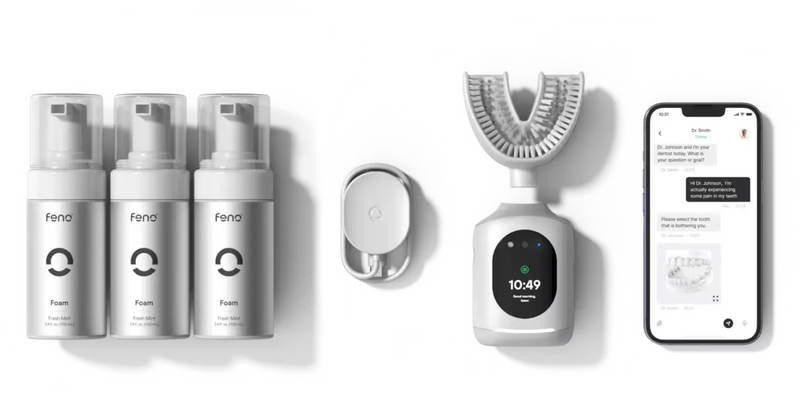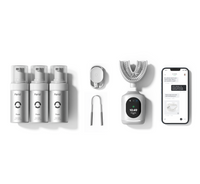
12 min read
How To Protect Your Teeth From Decay
Essential Takeaways
- U-shaped and mouth-shaped brushes: Designed for ease of use and effective cleaning.
- Early detection and treatment of decay is essential.
Tooth decay is a prevalent dental problem that can affect anyone with teeth, from young children to the elderly. This condition occurs when the bacteria in your mouth produce acids that attack the tooth's surface, or enamel. This process starts with the formation of plaque, a sticky film composed mainly of bacteria. When sugars and starches from food and beverages interact with these bacteria, acids form and begin to erode the tooth enamel, leading to decay. Factors like poor oral hygiene, frequent snacking on sugary foods, and not cleaning your teeth well can accelerate this process. Understanding these causes is the first step in preventing decay and maintaining a healthy mouth.

Best Practices in Oral Hygiene
Choosing the Right Toothbrush
Selecting an appropriate toothbrush is crucial for maintaining oral hygiene and preventing dental decay. The market offers a variety of options, but the choice generally depends on personal comfort and specific dental needs. For most adults, a soft-bristled brush is recommended as it is gentle on the gums while effective at removing plaque. The size of the brush head is also important; it should easily reach all areas of the mouth, including the hard-to-reach back teeth. For those with limited manual dexterity, such as the elderly or those with physical disabilities, an electric toothbrush might be a more suitable option.
Brushing Techniques
Effective brushing goes beyond just choosing the right toothbrush; it also involves mastering the correct techniques. To remove plaque effectively, the toothbrush should be held at a 45-degree angle to the gums, allowing the bristles to reach the tiny gaps between the teeth and gumline. From this angle, using a sweeping or rolling motion away from the gumline helps remove trapped food particles and plaque. In addition to the correct angle and motion, the pattern in which you brush is important. Gentle circular motions are recommended across all tooth surfaces. It’s crucial to brush systematically, covering all surfaces of each tooth — the outer surfaces, inner surfaces, and the chewing surfaces. To ensure thorough cleaning, divide your mouth into four quadrants and spend approximately 30 seconds on each, totaling around two minutes of brushing time.
The Role of Flossing
Flossing daily is a critical component of oral hygiene that helps prevent tooth erosion by removing debris and plaque that a toothbrush cannot reach. It is particularly important in cleaning the tight spaces between the teeth and along the gum line. Regular flossing not only helps keep your teeth and gums healthy but also reduces the risk of gum disease, which can be a contributing factor to dental decay if left untreated.
Importance of Toothpaste and Mouthwash
Fluoride toothpaste is effective in fighting decay as it helps to remineralize weakened tooth enamel and can even reverse early signs of tooth damage. When selecting a mouthwash, look for an antiseptic option that kills the bacteria responsible for causing dental plaque and bad breath. Alcohol-free mouthwash is preferable as it is less drying to the mouth. Together, the right toothpaste and mouthwash can significantly enhance oral hygiene and strengthen your preventive care routine.
Advanced Toothbrush Technology
Benefits of Smart Toothbrushes
These devices often come equipped with sensors that monitor pressure, duration, and coverage, providing feedback through a connected app to help users improve their brushing habits. Some models even offer real-time guidance to ensure that all areas of the mouth receive adequate attention. This technology is particularly beneficial for those who tend to brush too hard or too quickly, as it promotes gentle and thorough cleaning, significantly reducing the risk of tooth decay.
U-Shaped and Mouth-Shaped Toothbrushes
These are designed to simplify the brushing process, making it more efficient and user-friendly, especially for children and individuals with mobility challenges. These toothbrushes cover more surface area at once, ensuring that all teeth are brushed simultaneously with consistent pressure and coverage. The design often features silicone bristles that are gentle on the gums and enamel but effective in removing plaque.
Electric Toothbrushes
Electric toothbrushes provide several advantages over manual brushing, primarily through their ability to produce rapid bristle motions which offer superior plaque removal. These brushes are often equipped with oscillating or vibrating brush heads that can more effectively break down plaque and sweep it away from teeth and gum lines. Their ease of use also encourages better brushing habits, as the powered movement does much of the work.
Dietary Adjustments to Prevent Tooth Decay
Foods to Avoid to Reduce Decay Risk
To maintain optimal oral health and minimize the risk of tooth erosion, certain dietary choices should be carefully managed. Certain foods and beverages can significantly increase the risk of tooth decay by altering the environment within the mouth. Below, we delve into specific items that pose a high risk to dental health, explaining why minimizing or avoiding these can be beneficial:
- Soda and Other Sugary Drinks: When you consume these beverages, sugar coats your teeth and is metabolized by bacteria in the mouth, producing harmful acids. These acids can erode tooth enamel quickly. Additionally, many of these drinks contain phosphoric and citric acids, which further contribute to enamel breakdown. The combination of sugar and acids makes sodas and similar beverages one of the biggest threats to dental health, leading to cavities and tooth decay.
- Hard Candies and Chewy Sweets: Consuming hard candies and chewy sweets poses a double threat to teeth. These sweets not only contain high levels of sugar which bacteria in the mouth convert to acid but also tend to stick to teeth longer than other types of food. This prolonged contact time gives the acids more opportunity to work on the enamel, increasing the risk of teeth decay. Furthermore, chewing on hard candies can result in chips or cracks in the teeth, which are gateways for further decay.
- Starchy Snacks: Common snack items like chips, pretzels, and crackers are loaded with starches, which are complex carbohydrates that break down into sugars. These sugars, like those in more overtly sweet foods, feed the bacteria in the mouth that produce tooth-decaying acids. Starchy snacks also tend to stick to the crevices of the teeth, prolonging exposure to these harmful acids.
- Alcohol: Alcoholic beverages can be detrimental to oral health due to their dehydrating effect on the body. This reduction in hydration levels can decrease saliva production, which is critical for cleaning the mouth and buffering teeth against acid attacks. A dry mouth allows food particles and sugars to linger longer, and acids to more readily damage the enamel.
- Citrus Fruits: While packed with vitamins and nutrients, citrus fruits like oranges, lemons, and grapefruits are high in citric acid. Regular exposure to citric acid can erode tooth enamel over time, making teeth more susceptible to decay. Although citrus fruits are an important part of a healthy diet, it is advisable to consume them in moderation and rinse the mouth with water afterward to neutralize the acids. This can help mitigate their erosive effects and protect your enamel.
By avoiding or reducing the consumption of these foods and drinks, you can substantially learn how to treat tooth decay and maintain a healthier oral environment. Each item listed above carries specific risks that can compromise dental health if not managed properly. Being proactive about your dietary choices is an essential part of preventing dental problems and ensuring that your teeth remain strong and healthy.
Foods that Promote Oral Health
Eating foods rich in fiber, calcium, and phosphorus can help combat dental decay by helping to remineralize teeth. Dairy products like cheese and yogurt are excellent for teeth as they contain calcium and phosphates which help to strengthen tooth enamel and promote the production of saliva. Crunchy fruits and vegetables such as apples, carrots, and celery help clean teeth and freshen breath while providing essential nutrients.

Tips for Balancing pH Levels in the Mouth
Maintaining a balanced pH in the mouth is crucial for tooth decay treatment, as a neutral pH discourages the growth of harmful bacteria. To achieve this, drink water regularly to enhance saliva flow and cleanse the mouth. Chewing sugar-free gum containing xylitol post-meals can boost saliva production, neutralizing acids naturally. Minimize acid production by avoiding frequent snacking. Lastly, when consuming acidic drinks, use a straw to reduce tooth exposure.
Professional Dental Treatments for Decay
Treatment Options for Tooth Decay
Several professional treatment options are available to manage and fix tooth decay, depending on the extent of the damage. Early stages can often be treated with fluoride treatments that help to remineralize the enamel. When decay has formed a cavity, fillings are typically necessary to restore the tooth. In more severe cases, crowns or root canals may be required. For advanced decay that cannot be restored, the tooth may need to be extracted and replaced with an implant or bridge.
The Process of Getting Fillings
Getting a dental filling is a common and essential procedure for restoring teeth that have been damaged by decay. This straightforward method helps prevent further decay by closing off spaces where bacteria can enter. Here are the typical steps involved in getting a dental filling:
- Examination and X-rays: The first step in the filling process is a thorough examination of the affected tooth, along with the surrounding teeth and gums, to assess the overall oral health. The dentist uses X-rays to determine the extent of the decay and to visualize the internal structure of the tooth and the underlying bone. This helps in planning the treatment by identifying all the decayed areas that need to be addressed. X-rays are crucial for detecting decay that might not be visible to the naked eye, especially between teeth or under existing fillings.
- Anesthesia: Before the actual removal of decay, the area around the affected tooth is numbed using local anesthesia. This ensures that the patient does not experience any pain during the procedure. The anesthesia is typically administered via an injection into the gums near the tooth. It effectively blocks the nerves that transmit pain, providing comfort and ease for the patient during the removal of decayed material and the subsequent filling.
- Decay Removal: With the area numbed, the dentist proceeds to remove the decayed material from the tooth using a drill or laser. This step is critical to stop the spread of decay and to prevent further deterioration of the tooth. The choice between using a traditional drill and a laser depends on the extent of the decay, the dentist’s preference, and the equipment available. Removing all decayed material is essential to ensure that the filling bonds properly and the tooth structure is healthy.
- Tooth Preparation: After removing the decayed material, the dentist cleans the cavity of bacteria and debris. This preparation involves shaping the cavity to ensure that the filling material will fit securely and bond correctly with the natural tooth structure. The preparation may involve slightly undercutting the tooth to provide a better hold for certain types of fillings.
- Filling Placement: The dentist then selects a filling material suited to the patient’s needs, which could be amalgam, composite, or porcelain, based on factors like the location of the tooth, the extent of the decay, aesthetic considerations, and cost. The chosen material is carefully placed into the prepared cavity, then shaped to restore the natural contour of the tooth.
- Polishing and Adjustment: The final steps involve polishing the filling to achieve a smooth finish that mimics the natural shine of tooth enamel. After polishing, the dentist checks and adjusts the filling to ensure the patient's bite is correct and comfortable. This adjustment is crucial to avoid any discomfort or unevenness, which could affect chewing and the health of other teeth.
The process of getting a filling is a standard and effective way to restore dental health and functionality. By following these steps, dentists can ensure that the structure of the tooth is preserved and protected against further decay, providing patients with a long-lasting and aesthetically pleasing result.
The Importance of Regular Dental Check-Ups
Spotting Early Signs of Decay
During these visits, dentists use specialized tools and techniques to examine teeth for any signs of decay, such as soft spots or discoloration, that might not yet be visible or painful. These early appointments also allow dentists to monitor changes over time, ensuring that any new developments are addressed promptly to maintain oral health.
Integrating Professional Advice
During regular check-ups, dentists provide personalized advice tailored to each patient's specific needs. This guidance might include recommendations on improving brushing techniques, choosing dental care products like the best electric toothbrush or specialty toothpastes, and tips on diet adjustments that benefit oral health. This professional input is invaluable as it helps patients refine their daily oral hygiene practices to prevent dental problems before they start.

Continuing education on oral health and the awareness of new technologies and techniques are essential for preventing tooth decay and maintaining dental health. Innovations such as u-shaped toothbrushes and materials for tooth enamel restoration provide more options for dental care tailored to individual needs. By staying informed and proactive, individuals can significantly influence their dental health outcomes. Remember, preventive care is the most effective strategy against tooth decay and other dental issues, and it starts with the choices you make every day.

Feno Founders Edition Bundle
Advanced Oral Health in 20 Seconds with the Feno Smartbrush™
Get Yours Now!
Share




